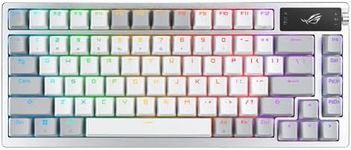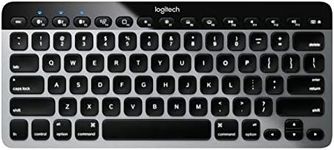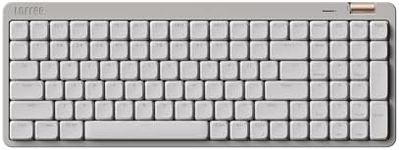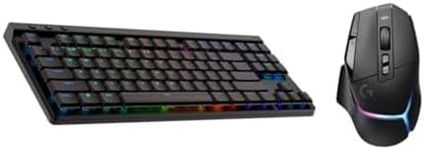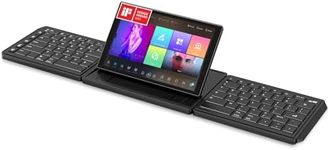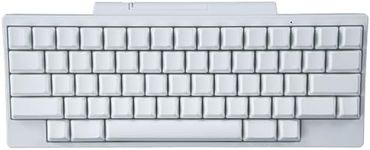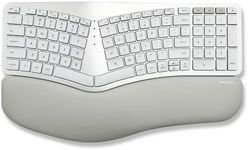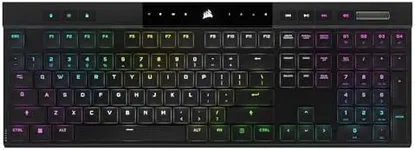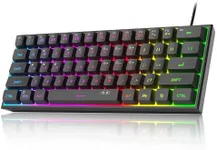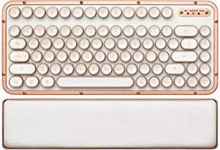Buying Guide for the Best Mac Wireless Keyboards
Choosing the right Mac wireless keyboard can significantly enhance your typing experience and productivity. When selecting a keyboard, it's important to consider various specifications that will affect your comfort, efficiency, and overall satisfaction. Here are some key specs to consider and how to navigate them to find the best fit for your needs.Keyboard LayoutThe keyboard layout refers to the arrangement of keys on the keyboard. This is important because it affects how easily you can type and access certain functions. Common layouts include QWERTY, AZERTY, and Dvorak. For most users, a standard QWERTY layout is the best choice as it is the most widely used and familiar. However, if you have specific typing needs or preferences, you might consider other layouts. Think about your typing habits and choose a layout that feels natural to you.
Key Switch TypeThe key switch type determines the feel and sound of the keys when you press them. This is important for comfort and typing speed. There are three main types: membrane, scissor, and mechanical switches. Membrane switches are quiet and have a soft feel, making them suitable for quiet environments. Scissor switches offer a balance between tactile feedback and quiet operation, often found in laptop keyboards. Mechanical switches provide the most tactile feedback and durability, preferred by many typists and gamers. Consider how much typing you do and your preference for key feel and noise level when choosing the switch type.
ConnectivityConnectivity refers to how the keyboard connects to your Mac. This is important for convenience and compatibility. Most wireless keyboards use Bluetooth, which offers a reliable and easy connection without the need for dongles. Some keyboards also offer USB dongles for a more stable connection. Ensure that the keyboard you choose is compatible with your Mac's Bluetooth version or has a suitable USB dongle. If you frequently switch between devices, look for a keyboard that supports multiple device pairing.
Battery LifeBattery life indicates how long the keyboard can operate before needing a recharge or battery replacement. This is important for uninterrupted use and convenience. Wireless keyboards typically have rechargeable batteries or use replaceable AA/AAA batteries. Rechargeable keyboards can last from a few weeks to several months on a single charge, while replaceable batteries can last even longer. Consider how often you want to deal with recharging or replacing batteries and choose a keyboard with a battery life that suits your usage pattern.
ErgonomicsErgonomics refers to the design of the keyboard that promotes comfortable and healthy typing posture. This is important to prevent strain and injury during long typing sessions. Ergonomic keyboards often have a split design, adjustable tilt, and wrist rests to support natural hand positioning. If you spend a lot of time typing, an ergonomic keyboard can help reduce discomfort and improve your typing posture. Evaluate your typing habits and any existing discomfort to determine if an ergonomic design is necessary for you.
BacklightingBacklighting refers to the illumination of the keys, which can be useful in low-light environments. This is important for visibility and ease of use in different lighting conditions. Keyboards can have different levels of backlighting, from single-color to RGB lighting with customizable effects. If you often work in dimly lit areas, a backlit keyboard can help you see the keys more clearly. Consider your typical working environment and whether backlighting would enhance your typing experience.
Size and PortabilitySize and portability refer to the physical dimensions and weight of the keyboard. This is important for desk space and mobility. Keyboards come in various sizes, including full-size, tenkeyless (without a number pad), and compact. Full-size keyboards offer all the keys you might need, while tenkeyless and compact keyboards save space and are easier to carry around. If you have limited desk space or need a keyboard for travel, consider a smaller, more portable option. Think about where and how you will use the keyboard to determine the best size for your needs.
